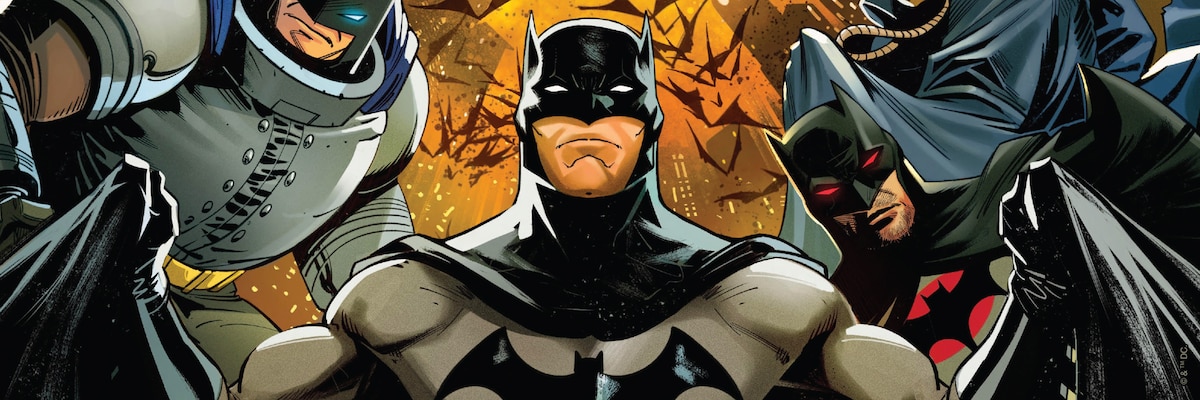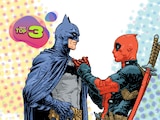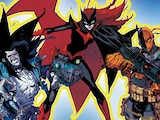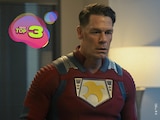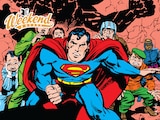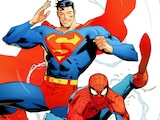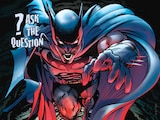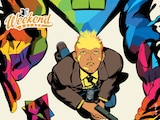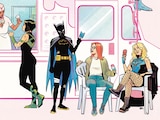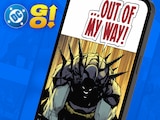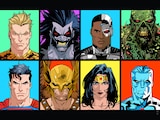Do you think you really know Batman? Maybe so. But do you know…every Batman? Dick Grayson? Jean-Paul Valley? Terry McGinnis? What about the Batmen of Red Rain, Red Son or Gotham by Gaslight? Batman: The Multiverse of the Dark Knight: An Illustrated Guide collects every single Batman that you need to know about into a single volume. 2021’s DC Comics Encyclopedia co-author Matthew K. Manning returns for this collection of profiles profiling DC’s many Batmen, with original illustrations by artist Flaviu Pop on every page.
We got a few moments in the Batcave with this multiverse-delving team to find out about their first Batman, what goes into making a Batman reference guide, and maybe figure out who this Batman guy really essentially is.

Tell us about your own personal introduction to the Batman Multiverse.
Matthew K. Manning: I’m a lifelong Batman fan who first got the bug when my dad brought home an issue of Batman and the Outsiders one day. When the ’89 Batman movie hit not too long after, I knew this was what I wanted to do for a living. I went back and read everything I could get my hands on, from the first Batman Archives to what was hitting the stands that week. Fortunately, all that allowance money proved to be a good investment, and I’ve written dozens of Batman books and comics over the last few decades.
Flaviu Pop: Being born in ’96, my first contact was through reruns of Batman: The Animated Series. I was instantly fascinated by the dark yet elegant pulp noir aesthetic and the masterfully executed action and character development. Comic books were not easily available here in Romania in the 2000s, especially in my small hometown, so most of my knowledge I acquired on the character at the time was through live action and animated movies, the Arkham game series and video essays. I instantly loved the character, so I made it my mission to learn and read as much as possible on him as I grew up. Now Batman comics and collectibles are a big part of my library and one of my main monthly expenses.
I'd like to know about the research process that went into putting this book together. How did you gather all the information you needed?
MKM: My personal bat-library contains a little over 15,000 Batman-related comics, so I didn’t have to look far. Batman is actually the easiest subject for me to research, as I’ve been “studying” him every new comic book day since I was in fifth grade. After writing so many guidebooks on the character, it’s usually about refreshing myself at this point rather than reading something new.
FP: I was fortunate to have a clear indication from Matthew and the editorial team regarding the versions of Batman I needed to illustrate. I happen to have a pretty big collection of Batman books, Prime Earth and Elseworlds, as well as an obsession for the character and an internet connection, so gathering the references was a pretty easy task. A lot of the research was already done prior to me starting the book as I’d been reading and drawing Batman for fun for a long time before working on Batman Multiverse.

Along the way, what was the most surprising thing you learned about Batman?
MKM: For me, the best part was rereading Elseworlds comics I haven’t truly sat down with since I was a kid. I’m happy to report that childhood favorites like Red Rain and Speeding Bullets are just as fun now as they were when I was in junior high.
FP: Despite being familiar with a lot of the versions illustrated in the book, I have to say, I was surprised to find so many iterations of the character. He is probably the most flexible character ever created. I think my main surprise was discovering Batsaur, the Jurassic League version of the character, and Frankenstein Batman. Being one of the most popular comic book characters of all times, there are so many stories that remain hidden for a lot of readers, and for me, it was a blast discovering lesser-known stories from the past and present.
One of my favorite parts of this book is the framing device of all these entries being the personal files on each incarnation of Batman from Barbara Gordon's perspective as Oracle. How did you land on that conceit?
MKM: When I was first approached with this project, the idea was for the book to be from Alfred’s point of view. Since Alfred died recently in Tom King’s run (and somehow he’s still dead!), I thought maybe we should switch gears and tackle this from Oracle’s perspective. She’s another favorite of mine, so it was an easy transition—although I would’ve liked to add a bit of Alfred’s trademark snark here and there…
FP: Obviously that was the work of Matthew. Personally, I love the idea. I love Barbara as both Batgirl and Oracle and I think her personality and skills make her the perfect option as the narrator of the book. She’s a cerebral character with a thirst for knowledge and we get the joy of learning about multiple iterations of Batman with and from her.

Matthew, this isn't your first time writing about Gotham. In addition to reference material, you've written issues of The Batman Strikes, a tie-in series to the 2004 The Batman cartoon, and Batman/Teenage Mutant Ninja Turtles Adventures, a crossover between the 2012 Teenage Mutant Ninja Turtles television series and 1992's Batman: The Animated Series. How is writing Batman on the animated fringes of the multiverse different from approaching Batman of Earth-0?
MKM: Batman’s really not all that different coming from those particular universes. A little bit younger in The Batman Strikes and Beware the Batman worlds, a bit more like his adventurous ’70’s counterpart in Batman: The Animated Series. But I’ve written the comic book version of Batman’s voice a good deal over the years, too, from the large faux scrapbook The Batman Files (Andrews McMeel) to comic book stories set in the DCU, to his examinations in DC Comics: Anatomy of a Metahuman (Insight Editions). He’s always come second nature to me, in whatever incarnation.
What's the most fun version of Batman to draw, and which is the most challenging?
FP: This is a very challenging question for me as I can’t think of only one favorite. Any chance to draw any version of Batman is a blast.
The ones that I enjoyed the most were Batman Beyond, Gotham by Gaslight and The Dark Knight Returns. I tried to use different techniques, especially in terms of coloring to make them distinct. The whole book was a style experiment for me as the variety of styles got me out of my comfort zone.
The most challenging ones were the Mechsuit Batman and the Kingdom Come spread, each for different reasons. I like to self-sabotage every now and then in the pursuit of learning new things, which is why on the Mechsuit Batman illustration, I picked a trickier angle which required me to draw tech in perspective, which happens to be one of my weaker spots. On the Kingdom Come spread, I wanted to convey the intensity of the big battle originally illustrated beautifully by the great Alex Ross. Obviously, I couldn’t live up to even a quarter of his skills, but I am very happy with the result. It was a great learning experience for me.

For this project, you've studied every possible permutation of Batman across all stories and all realities. You've seen him as a villain, as a vampire, as a Green Lantern and so much more. So, I have to ask, when you take all these different variations of Batman into account, who really IS Batman at his core? What is it that makes all of these different Batmen...Batman?
MKM: What’s incredible about Batman is his flexibility. Sure, there are certain elements that any universe needs to include, but unlike a lot of heroes, Batman has really proven he can work well in a variety of genres and tones. The camp of the ’66 show, the realistic depictions in works like Batman: Year One and The Batman film, the art deco noir of Batman: The Animated Series, the sci-fi infused Morrison years on JLA—there’s not a lot of places where a Batman can’t thrive. So, when you look at that from the multiverse’s perspective, placing him in weird settings or impossible realities, he almost always fits.
FP: I think every version of Batman, hero or villain, at its core represents the epitome of willpower. Batman is obviously a symbol of justice, a quality which does not apply to his malevolent counterparts. He’s a layered character that, depending on the story, can serve as both inspiration as well as cautionary tale about the dangers and sacrifices related to obsession. It helps us aspire to become the architects of our own existence in the face of the absurd, and to try and leave a better mark on the world.
MKM: Underneath it all, Batman is a childhood vow made real—the product of the imagination of a broken little boy who saw his parents die in front of his eyes and wanted to prevent that from happening to anyone else. The details can change, but if the motivation comes from that raw place of fear and determination, the end result will almost always feel like an authentic Batman story.
Batman: The Multiverse of the Dark Knight: An Illustrated Guide by Matthew K Manning and Flaviu Pop is now available in hardcover from Insight Editions (and would make a great holiday gift for any Batman fan in your life…you know, just sayin’).
